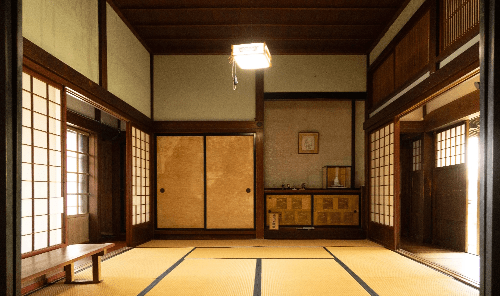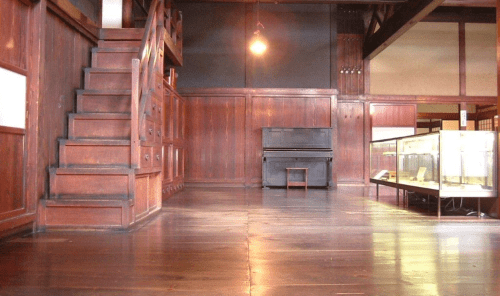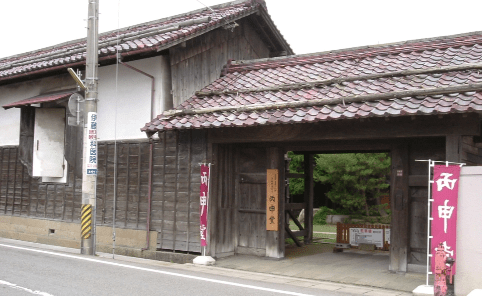It is a structure built in 1896 by Koemon, the 7th head of the Kazama family, as a residence and a business base (store). The characteristics of a merchant house, such as a spacious wooden floor room and storehouses, still remain.
It was designed to be earthquake-resistant in response to the earthquake that struck neighboring Sakata City in 1894. That is why the 19 Japanese-style rooms and the central pillar still exist as they originally were.
In 1996, the main building, front gate, storehouses, and board fences were nationally designated as Registered Tangible Cultural Properties of Japan. And, in the year 2000, the main building, storehouses, restroom, and bathroom were listed as Important Cultural Properties of Japan.
We invite you to enjoy the rich, interesting, old Japanese culture preserved here.

Kozashiki
This is a room created for guests. Elaborate designs are found in doors and nail head covers.
Also, make sure to check the Arita ware toilet created for use by guests.
This room was used in filming the movie Semi Shigure.
Also, other rooms like the butsuma (Buddhist altar room), kamizashiki (the most prestigious room), and wooden floor room were used to film movies like Sword of Desperation (Hisshiken Torisashi) and Snow Prince.


Tori
One of the must-see spots is the long, open view of the “tori” passage.
14.5-meter single cedar wood is used for the nageshi (horizontal beam running between columns) and the ceiling’s saobuchi (battens holding the ceiling boards).

Zashiki
The room has a high ceiling and is installed with osaranma, transoms with thin bamboo sticks lined up. Light and wind can pass through even if partitioned with doors (fusuma), making it comfortable in summer without using an air-conditioner. On the other hand, it is extremely cold in the winter, so the property is closed from December to February.
Heishindo’s year starts in March by decorating the room with hina dolls, like in the photo.

Kitchen and Beams
Kitchen of about 109 square meters. This was something like what is now called a staff canteen. Since the Kazama family, who was the landlord, had many tenants, this place was also used as a place of social gathering.
The truss construction of putting together triangles complexly is used for the beams of the ceiling, making it earthquake-proof. It is a very rare architecture created with quake-resistant structure in mind by the carpenters at the time.
INFORMATION
INFORMATION| Public open period | : | April 15 – November 30 |
|---|---|---|
| Closed day | : | July 13 (Obon festival in Tsuruoka City) |
| Open hours | : | 9:30–16:30 |
| Admission fee | : | Heishindo and Shakado common ticket Adult 500 yenChild 200 yen |

ShakadoThe Kazama Family’s Former Second House
Kazama family’s former second house built in 1910.
It was used for entertaining guests.
The site is about 2,710 square meters. And the floor space is about 79 square meters. Shakado, known for its large Japanese garden, is located approximately 50 meters north of Heishindo.
Because of its excellent structure and design, it has been designated as a Registered Cultural Property of Japan in 2002 as a valuable piece of material for thinking about second house architecture.


Framed Calligraphy “Muryoko”
Calligraphy written by Mokuan, a priest of a Zen temple in Kyoto, who was called one of the Obaku no Sanpitsu (three priests of the Obaku Zen school who excelled in calligraphy) (see photo). The word Muryoko is derived from a Sanskrit word meaning “One who has infinite light.”
Other calligraphic works, such as waka poems, and paintings of seasonal flowers, are used on furnishings too.

Chin-kuguri
Chin-kuguri (a hole in a wall between an alcove and shelves) with excellent carvings of cranes and a pine tree embedded into it (see photo).
Fudegaeshi (a piece of wood on the edge of shelves and desks to stop brushes from falling) representing incoming and receding ocean waves. Wooden board cut from a hundreds-of-years-old zelkova tree with a tamamoku pattern (circular burls in wood grain) appearing widely and in a balanced way is extremely rare and top quality. There are also a great many must-see furnishings, such as fusuma (sliding doors) and tsuitate (screens), preserved here.

Seasonal Garden
Several dozen types of flowers and plants, including cherry trees, azaleas, camellias, fringed irises, maples, and the symbolic Chinese quince tree, welcome guests with their look according to the seasons.
Besides the Shakado, where you can view the beautiful garden, there is also the Shakado Tea House, which is a tea-ceremony house where you can take your time and admire the scenery.



